From setting up your first task to monitoring your team’s progress and activities, this guide will help you get started with Plaky and boost your work productivity.
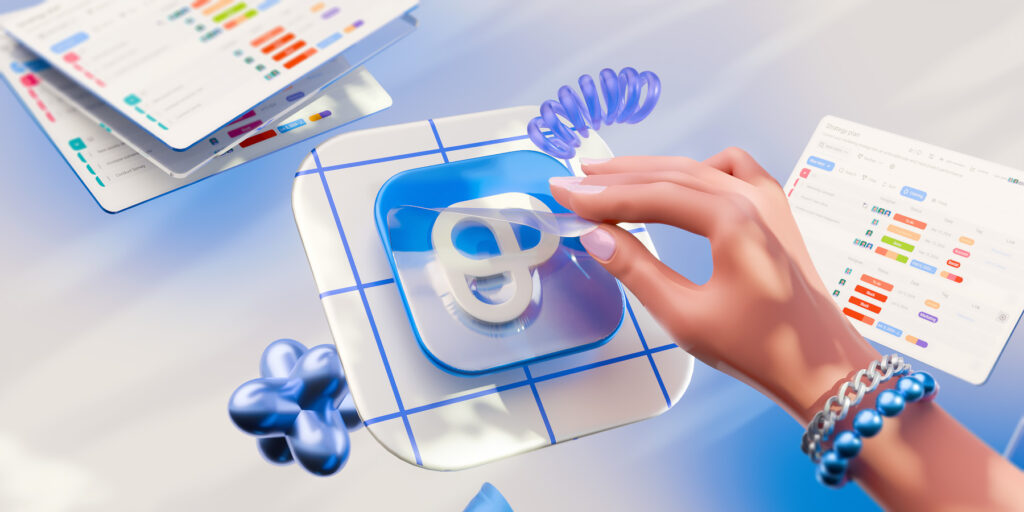
What is Plaky?
Plaky is a flexible and highly customizable project management tool that helps teams from all industries plan projects and stay on top of their tasks.
Work becomes transparent as you track progress and see what everyone on your team is working on. With Plaky, you don’t have to worry about missing anything important, as you will get in-app and email notifications when any change occurs.
Let’s take a closer look at how you can jumpstart your project and work more efficiently with Plaky.
Starting a project in Plaky
To make the entire process easier on you, here are the basic steps to starting any kind of project in Plaky.
#1 Create a project board
In Plaky, a board is a project-dedicated space where you can plan and organize everything you do at work. It’s a visual representation of your team’s tasks, workflows, and processes.
Here’s how you can create a board in Plaky:
- Navigate to the Space menu.
- Click on the “+” sign and choose New Board.
- Select Create from scratch, Create from template or Create from file.
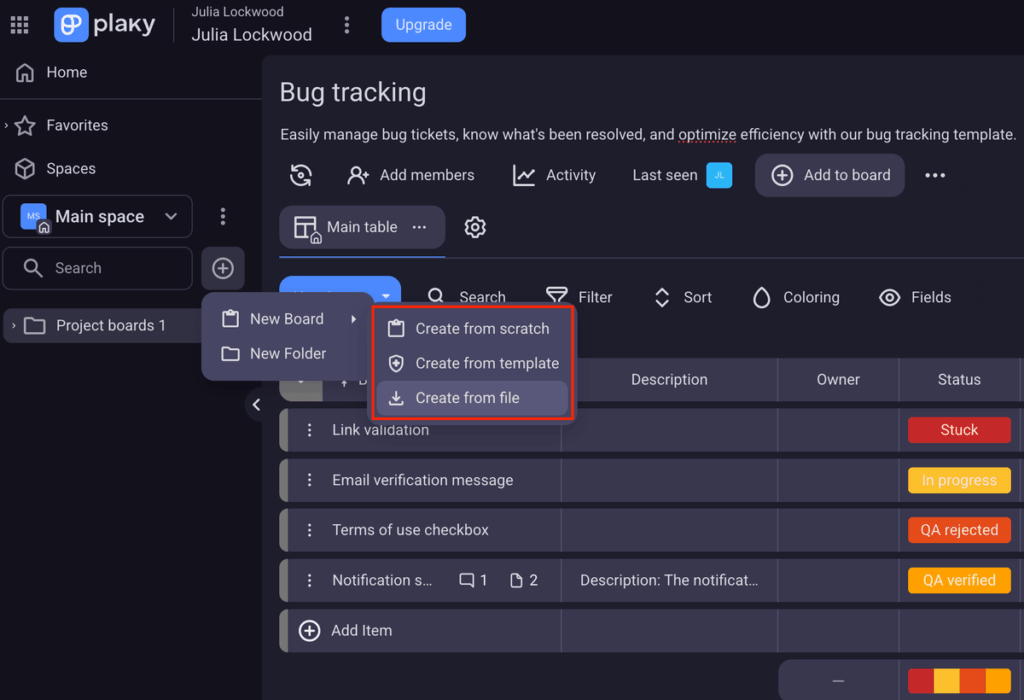
💡 Plaky users get to create an unlimited number of boards across all plans — even the free plan.
Creating a board from scratch
If you’d like to start with a blank canvas, select the Create from scratch option from the New Board menu. Then enter the board’s name. To finalize the action, click Create board.
At this point, you can also add a description to ensure everyone on the team understands the board’s purpose.
💡 If you think this workflow isn’t ideal for your type of work, don’t worry. Plaky is highly flexible and customizable software that can adjust to your needs, allowing you to organize everything within the same platform, from complex projects to simple tasks, events, clients, and much more.
Creating boards from templates
Besides starting a board from scratch, Plaky gives you the option to import one from another platform or kickstart your project using pre-made templates designed to meet the needs of various industries, businesses, and teams, including:
- Marketing,
- IT,
- Sales, and more!
Our board templates have a pre-defined structure that has been tailored to the needs and the most common practices of a range of industries. But, you can always modify and customize them further to fit your workflow.
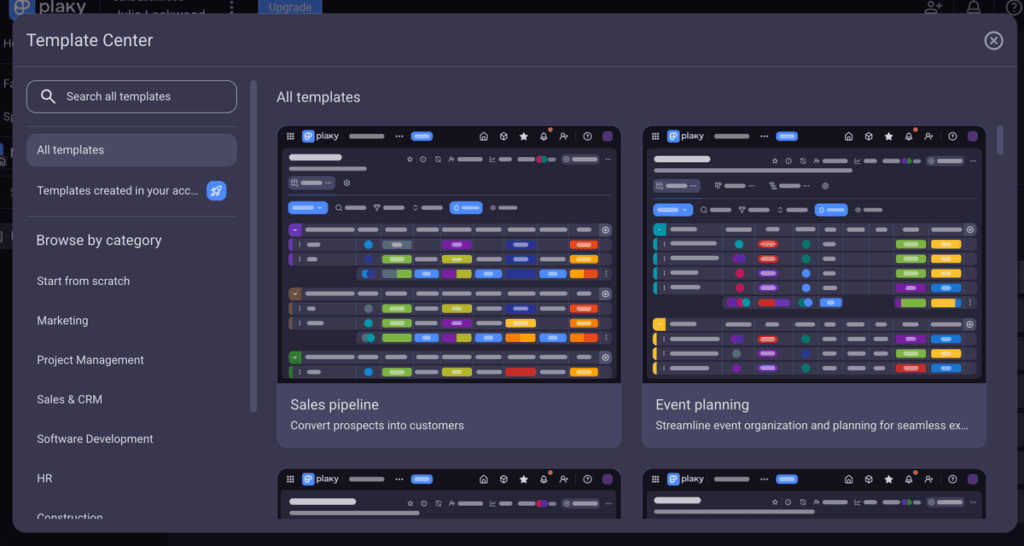
Create a project board in Plaky now
💡 Change the board type for privacy reasons and set it to be either public — open to anyone from your team — or private — available to only certain team members (available on Plaky’s Pro and Enterprise plans).
#2 Create item groups
You’ll notice that the newly created board consists of rows and fields. Rows represent individual tasks, while fields can be different stages of the project or different task categories.
Tasks (items) in Plaky are organized into groups.
A group is a section on your board that contains your tasks and represents a time frame (quarters or months), a project phase, a stage, or any other category through which you want to organize your future tasks.
Here’s how to create an item group in Plaky:
- Hover over the New item section on your board.
- Click on the downward arrow and choose New group of items from the drop-down menu.
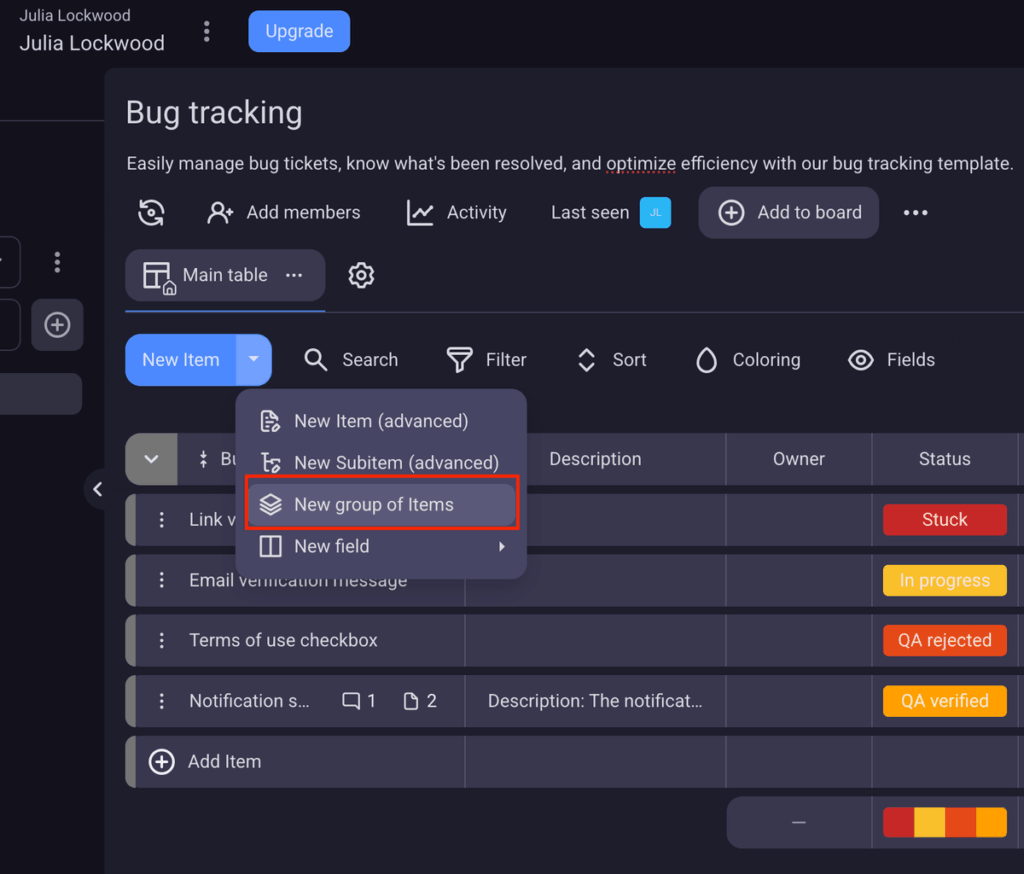
💡 Groups can be color-coded, which makes it easier to visually access the information on your board.
#3 Add your tasks
Items (tasks) are added to groups and represent the fundamental building blocks of your project, i.e., any tasks, activities, or simple to-dos that you and your team are working on.
Here’s how to create an item in Plaky:
- Click on the “+” button in the column where you want to add the task.
- Enter the task title in the text field.
- Press Enter to complete the action.
Just make sure to give your tasks action-oriented titles and define them clearly.
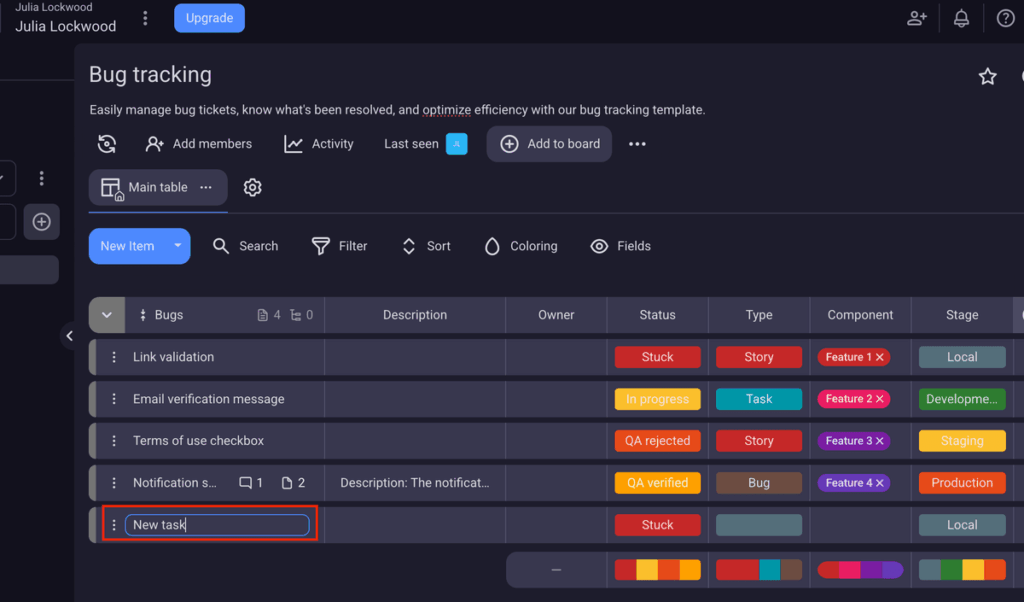
#4 Customize your board with fields
Custom fields in Plaky can help you further categorize your tasks by specific information related to your project. Currently, there are 9 different types of custom fields to choose from, and all of them are essential for good board organization.
In short, you can add a relevant field to display the specific data you want to see on your board. Here’s how Plaky’s custom fields can be used to populate your board:
- Person field — can be used for assignees, showing your team who is responsible for what. You can include one or more members from your organization or even add a whole team. They will be instantly notified via bell or email notifications that they were assigned to this specific task.
- Text field — used to add short explanations, descriptions, and other details about your tasks.
- Rich text field — can be used for task descriptions to add a bit more context and explain the tasks so that they’re transparent and easily understood by all board members. Here you can also add links, make checklists, and/or emphasize important task instructions.
- Status field — indicates where a task currently stands progress-wise. This field comes with its own color-coded custom labels (e.g., To do, In progress, Done), which help you better understand which tasks require your attention. You can also use the same field to indicate task priority — high, medium, and low priority.
- Date field — indicates due dates for tasks you’re currently working on. The date field can also be used to set the launch date, the initiation date, or the date of task execution, as well as other time-related information.
- Number field — used to associate project information with specific numerical values, e.g., budgets.
- Link field — used to attach URLs (e.g., files, external resources, or tools) directly to tasks for easy reference.
- Tag field — helps you group and categorize tasks using custom labels, allowing you to filter and quickly find related items across your board.
- Timeline field (available on paid plans) — allows you to set start and end dates for tasks, giving you a clear visual representation of your project schedule. This field is ideal for tracking task durations, planning deadlines, and ensuring your team stays on track.

What else can you do in Plaky?
Once you have your basic board, it’s time to customize it further with board views, conditional coloring, summary rows, and board automations.
Board views
Board views are the best way to visualize the data on your board and see your project from a different perspective.
Here’s how to create a new board view in Plaky:
- Click on the gear icon and choose Create new view.
- Choose the type of view you want to create: Table, Kanban, Gantt, or Chart view.
- Add the board name.
- Toggle the private or public setting.
The table view is the default view, while all the other views can be generated based on your needs and preferences.
Resembling an Excel sheet, the table view is organized into rows and fields and is ideal for managing complex projects with lots of data.
This view provides you with an easy-to-digest but comprehensive overview of tasks. It’s the best option for detailed data entry, so it’s the default view where you can first add all the information and then generate other views based on it.
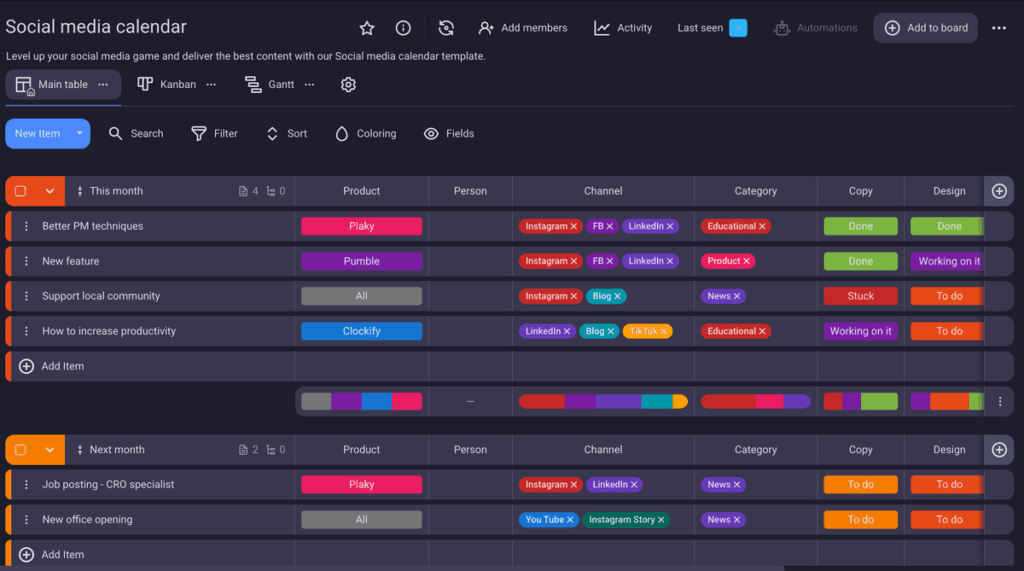
The Kanban view is a great option for Agile teams that want to have a keen insight into how their tasks are progressing. It is based on the Kanban methodology, which categorizes tasks depending on their status (usually To do, In progress, Done).
Once you generate a new Kanban view, you will see all of your items grouped by status.
By clicking on the gear icon (Settings), you can choose to hide some item information, turn off dividing by group, or even group items by some other status field.
💡 You can organize your board by sorting items based on specific field values or filtering it by certain criteria, e.g., assignees. You can save this configuration for each view.
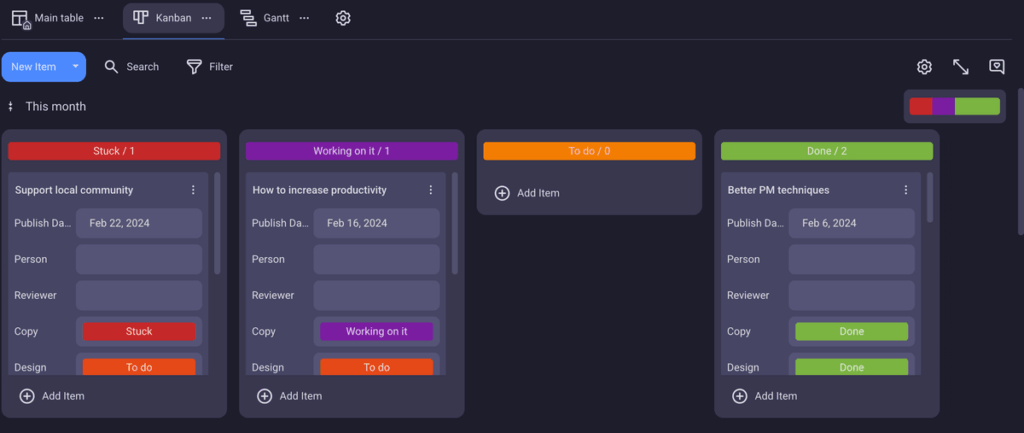
Another option is to create a Gantt chart view, which visually displays the project timeline, offering you a clear overview of your tasks and their progress.
In the Gantt view, tasks are depicted as horizontal bars on a timeline, providing clarity on task durations and the project schedule.
You can customize your Gantt fields, grouping, coloring, and labeling criteria, as well as adjust additional view settings in the Gantt view settings.
Keep in mind, though, that the Gantt chart view is available on paid plans only.
💡 Views are also super useful because each team or team member can generate their own view and include only the data they find interesting.
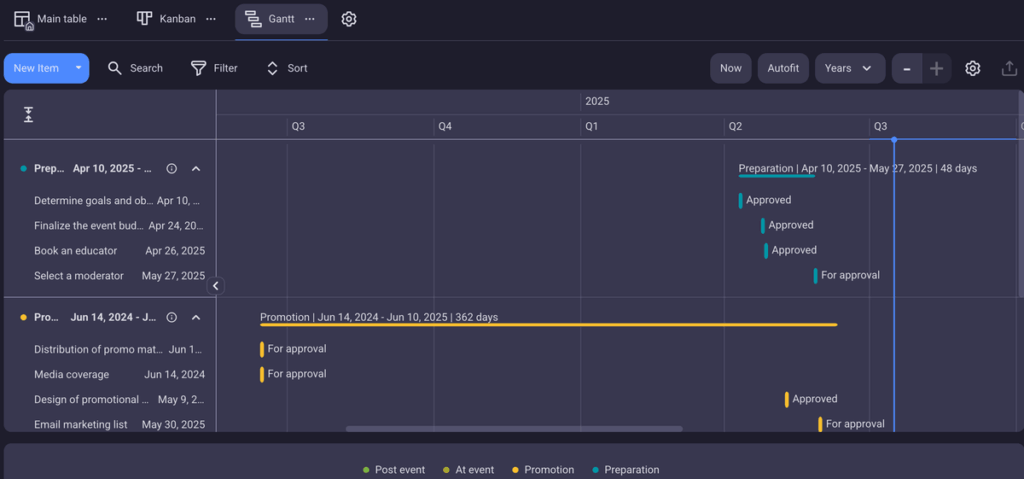
Finally, you can generate a chart view, which should help make any confusing data more digestible and allow you to analyze your team’s productivity, performance, and more.
Overall, charts can help enhance clarity across the entire project and improve decision-making. Giving you real-time insights into multiple sets of data, charts not only makes project management easier but also more effective overall.
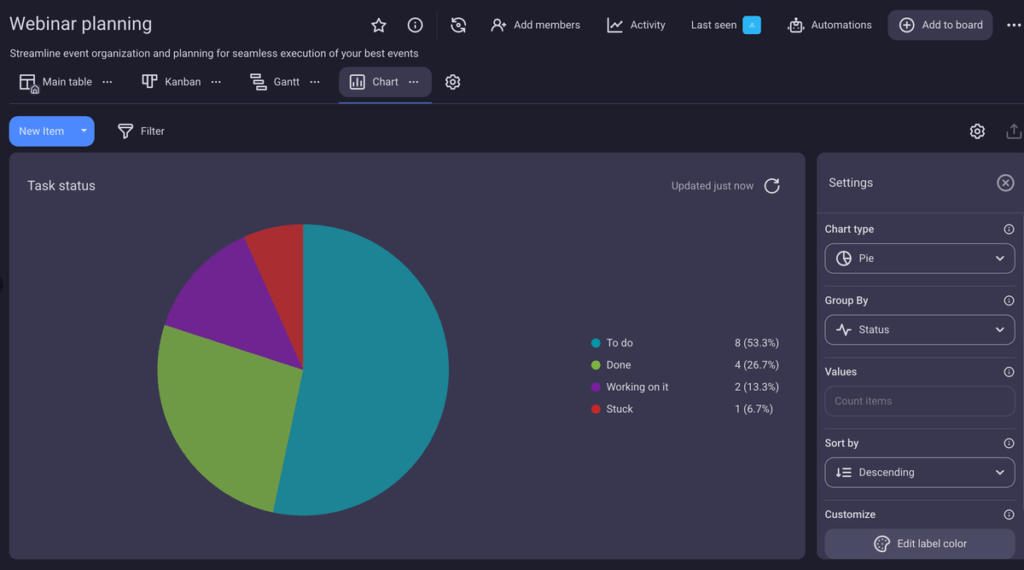
Start your 14-day free Plaky trial now
Multiple views
Users can save each filtered board as a separate view and give it a name that reflects the data it displays, making it easy to find and access. For example, you can filter by the Assignee field to quickly see tasks assigned to each team member.
Private views
If you want a personal version of your board that only you can access, you can also create a private view. This view will keep your information secure and visible only to you.
Conditional coloring
Conditional coloring in Plaky allows you to set specific color rules for items based on criteria like priority, status, due dates, or any custom field you choose.
For example, you can set high-priority tasks to appear in red, completed tasks in green, or overdue items in yellow.
These kinds of visual cues make it easier to quickly identify important tasks, monitor deadlines, and understand the overall status of your project at a glance.

💡 Conditional coloring is available on Plaky’s paid plans, but you can try it out by signing up for a free 14-day trial.
Summary row
Another visual indicator of key data in Plaky is the summary row. Think of it as a quick snapshot that gives you totals, averages, or crucial data points so that you can instantly see how things are going and make smarter decisions on the fly.
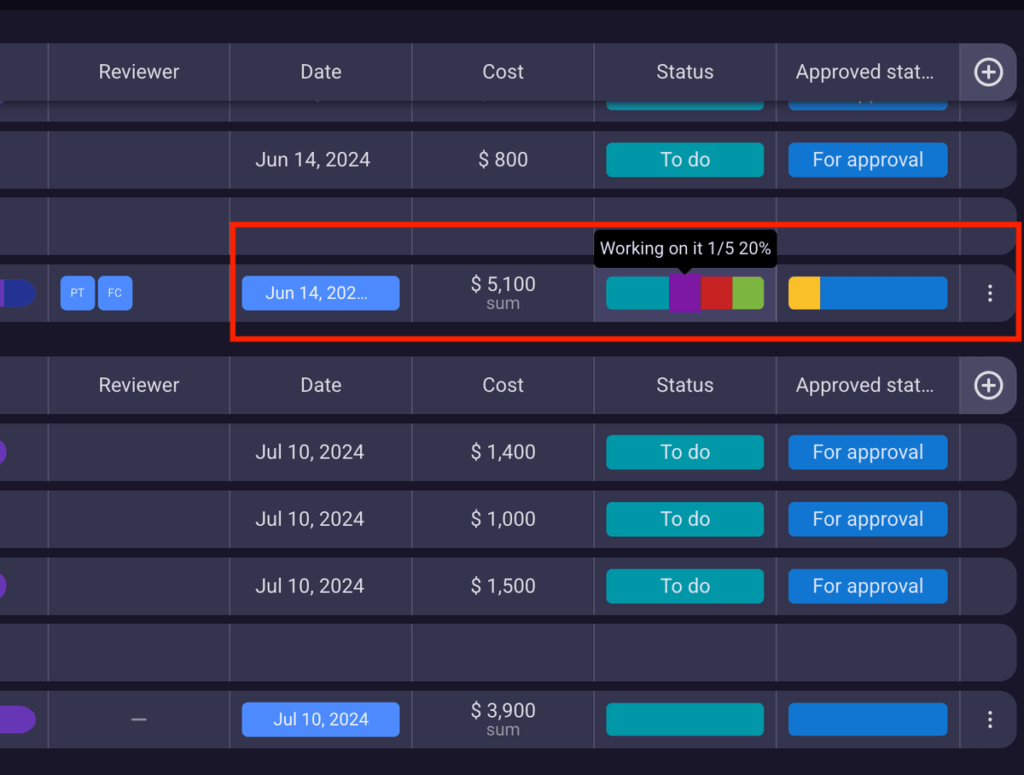
Board automations
Board automations in Plaky can help you build more efficient workflows and reduce repetitive tasks to a minimum.
To implement board automations, all you have to do is set specific triggers that will initiate certain actions once they are activated.
The automations follow a simple formula:
When something happens (trigger) → Then do something automatically (action).
If you want, you can also add conditions to your automations to further ensure a trigger’s accuracy.
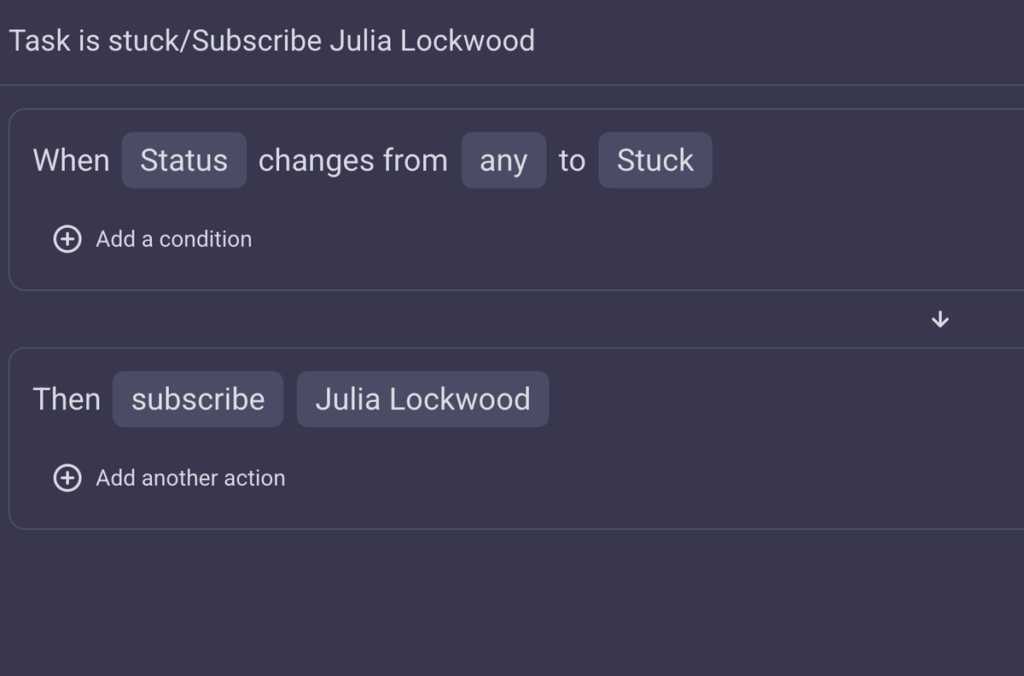
💡 Board automations are available on Plaky’s paid plans. However, you can try them out by signing up for Plaky’s 14-day free trial.
💡 Plaky Pro Tip
Learn how you can use board automations to build a more efficient workflow in Plaky:
How to organize your Plaky boards
There are a few ways you can organize your boards in Plaky to streamline your workflow further.
First, you can move tasks from one group to another by dragging and dropping them where you think they should belong.
The same can be done with fields and even groups — just drag and drop them around.
For more efficient organization, you can also duplicate a board, item, or specific field, with or without its values.
Boards can even be added to Favorites — just click on the star in the right-hand corner of your board. You can then easily find and access your favorite boards from the left-hand side panel.
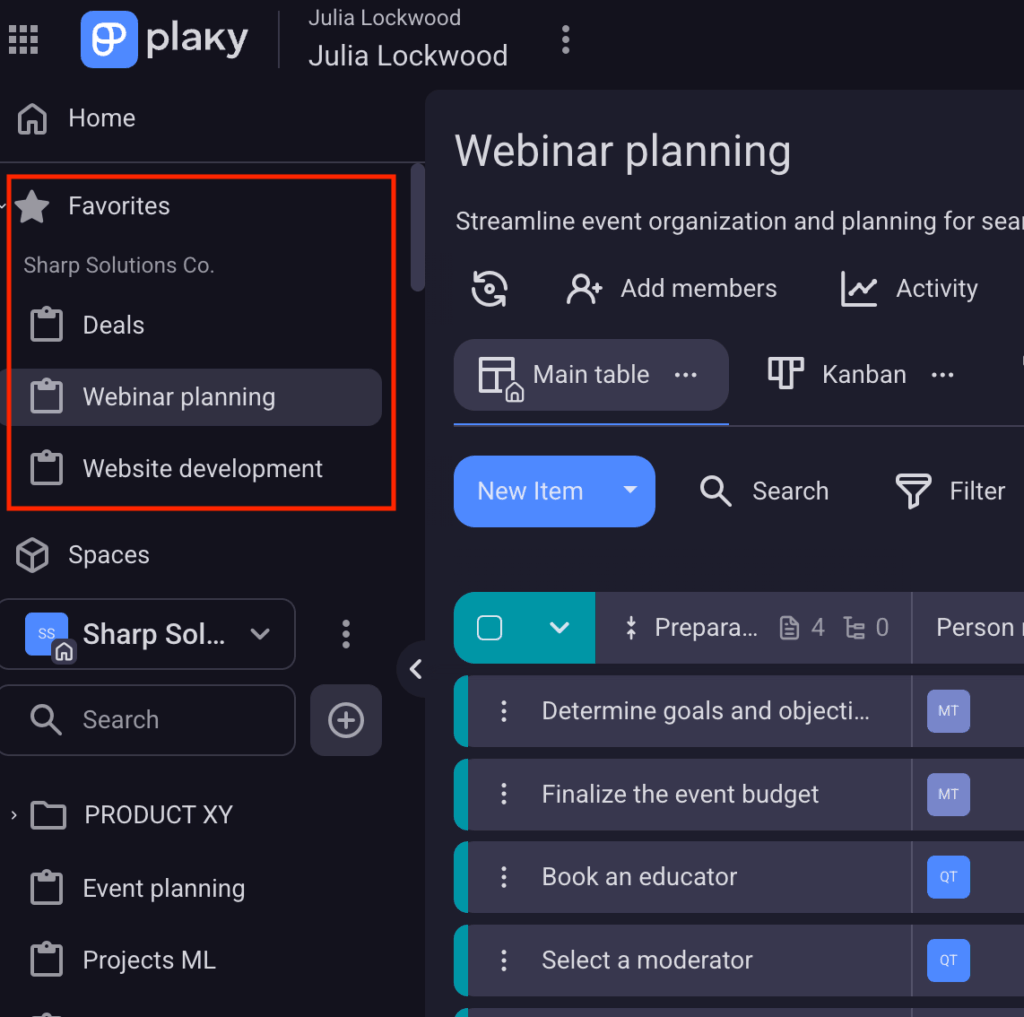
Folders
In Plaky, you can organize your boards into appropriate folders, giving you and your team an organized overview of all your projects in the workspace. To get a better overview of each folder, you can expand and collapse it with just one click.
Spaces
With spaces, you can manage different sections dedicated to multiple departments, teams, projects, tasks and all related correspondence with your coworkers in one place.
User roles
Plaky offers a range of different user roles and access permissions that allow teams to have better control of their workspaces and get a more comprehensive overview of their tasks and progress.
Based on the access level, there are 3 user roles:
- Admin,
- Member, and
- Viewer.
As an admin, you have all permissions available on your account, so you can:
- Modify and configure the space (one or more),
- Modify, configure, and change boards and tasks,
- Control access permissions for other users, and
- Transfer ownership to team members.
You as a board owner can do everything, while board members, depending on their permission level, can:
- Edit everything,
- Edit content, or
- Write updates only.
You can invite team members via their email addresses, and then organize them into teams. Overall, it’s much easier from an administrative perspective to have them grouped into departments or teams.
Collaborating in Plaky
Once all your team members have been onboarded, working together will be easier than ever — Plaky is all about good planning, organization, and collaboration.
Everything in Plaky is very transparent, and the context is clear to everyone since all of the work happens within the item cards.
Comments
Each item card comes with its own comments section — the speech bubble icon shows how many comments there are in total.
You can access the comments section whenever necessary and see a history of all task-related updates. Check prior updates or write new comments so that you and your teammates easily stay on top of all your tasks.
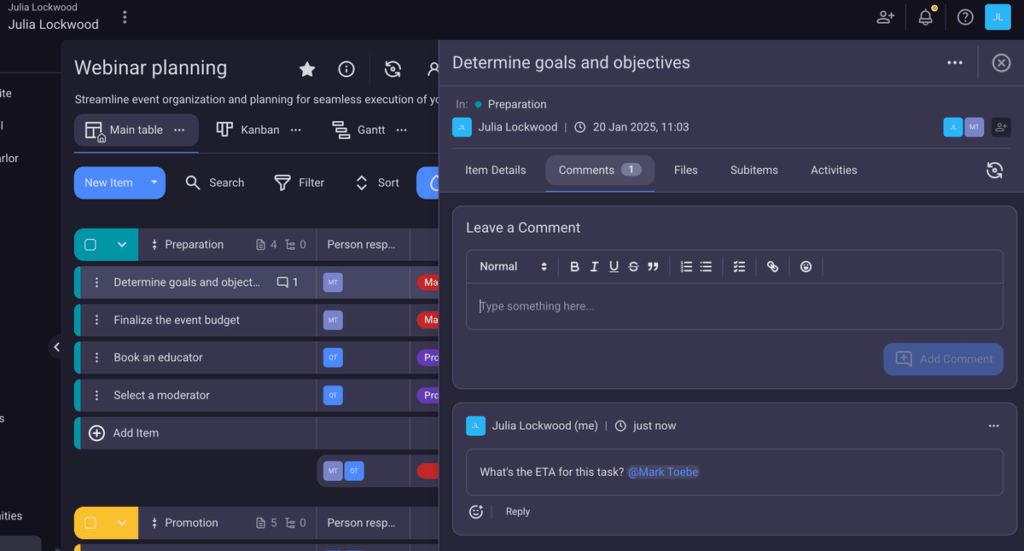
If you notice that someone from your team is working on a task you can help with, @mention them in the comments section. The instant bell notification will lead them directly to the comment, which speeds up communication overall.
Replies and reactions
You can also keep the conversation going with dynamic comment threads where team members can respond to updates and react using likes or emojis.
This keeps communication fun and engaging, clears up any questions, and helps everyone feel connected and involved in the project.

Files
Each item card also comes with its own Files tab, where users can share documents, images, and all other key project-related documentation. This way, Plaky becomes your very own centralized information hub where nothing falls through the cracks — and all data is readily available at all times.
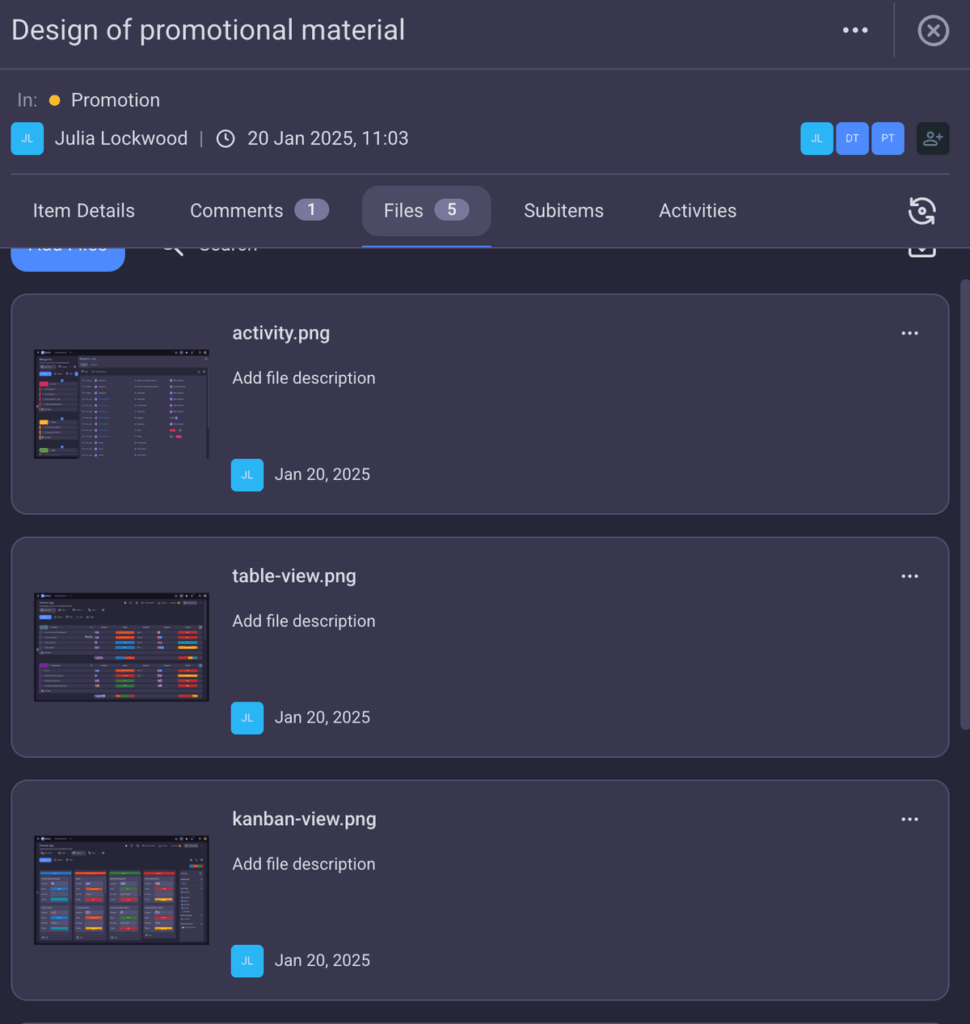
Notifications
Notifications help us stay informed at all times about any new updates or changes.
With bell notifications, you’ll stay in the loop regarding any information that’s specifically relevant to you. So, you won’t miss anything important concerning projects you’re involved in.
Beside bell notifications, Plaky also offers email notifications. You’ll get both when:
- You’re subscribed to a board,
- Someone assigns you to an item,
- Someone mentions you in a comment or reply, etc.
Once you click on the link in your email, you’ll be taken to the relevant section in Plaky where the action you were notified about occurred.
Of course, you can also change your notification preferences and select which ones you want to receive and where. To customize your notifications in Plaky, go to the profile settings in the left-hand side panel.
Activity log
As teams start to grow and take on extra work, tracking completed tasks and changes can become a bit of a challenge. Plaky solves this problem for you with its activity logs.
There are several types of activity logs available in Plaky:
- Board activity log — shows the most recent changes made to the board, e.g., recently subscribed team members, deleted items, etc.
- Item activity log — displays recent item changes, such as changed statuses, deadlines, and similar.
- Last seen — shows which team members were recently active and how long ago.
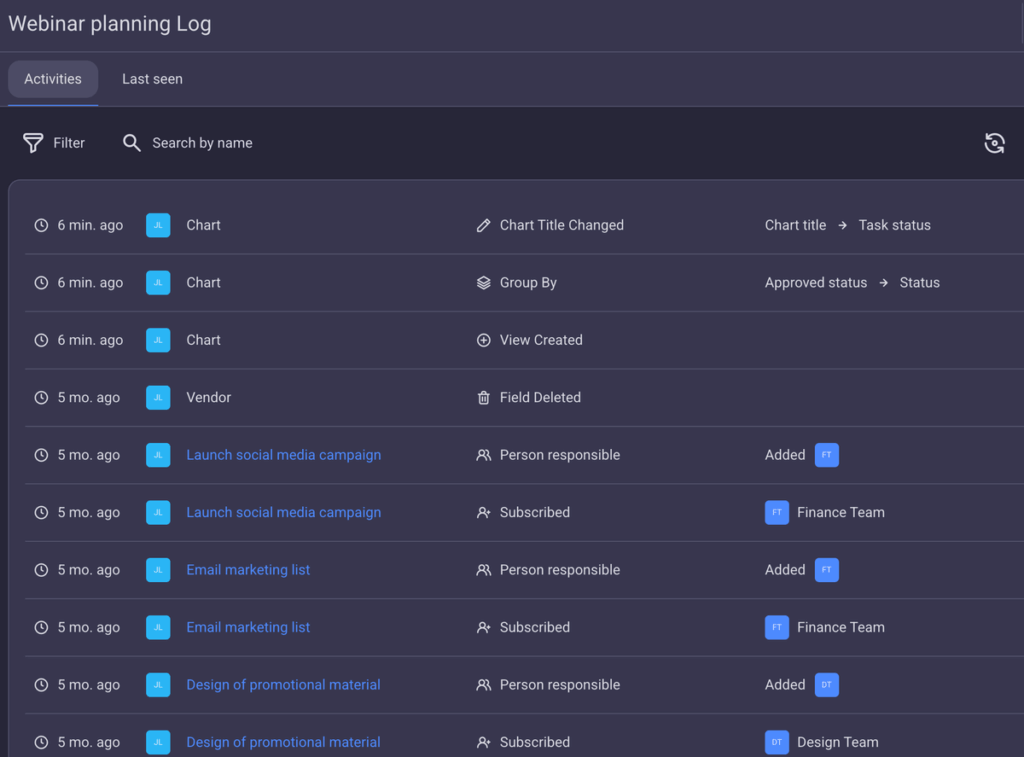
Get started with Plaky now
Visit our knowledge hub, blog, and help center to learn more about Plaky and project management in general.
Feel free to rely on our resources while using our tool for better and more flexible work organization.
How we reviewed this post: Our writers & editors monitor the posts and update them when new information becomes available, to keep them fresh and relevant.



